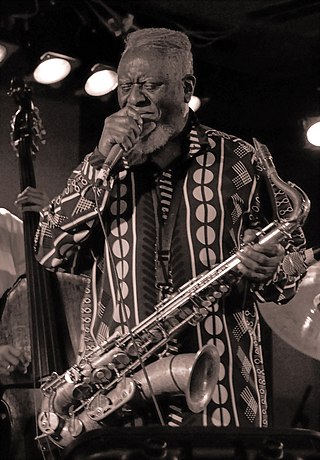
Pharoah Sanders was an American jazz saxophonist. Known for his overblowing, harmonic, and multiphonic techniques on the saxophone, as well as his use of "sheets of sound", Sanders played a prominent role in the development of free jazz and spiritual jazz through his work as a member of John Coltrane's groups in the mid-1960s, and later through his solo work. He released over thirty albums as a leader and collaborated extensively with vocalist Leon Thomas and pianist Alice Coltrane, among many others. Fellow saxophonist Ornette Coleman once described him as "probably the best tenor player in the world".

Rashied Ali, born Robert Patterson was an American free jazz and avant-garde drummer best known for playing with John Coltrane in the last years of Coltrane's life.

Ptah, the El Daoud, recorded and released in 1970, is the third solo album by Alice Coltrane. The album was recorded in the basement of her house in Dix Hills on Long Island, New York.
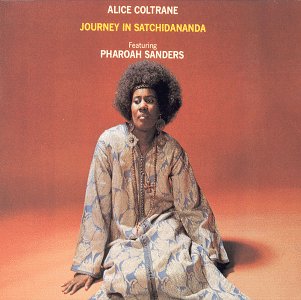
Journey in Satchidananda is the fourth solo album by Alice Coltrane. Four of the album's tracks were recorded at the Coltrane home studios in Dix Hills, New York, in November 1970, while the remaining track was recorded live at the Village Gate in July of that year. It was released by Impulse! Records in 1971. On the album, Coltrane appears on piano and harp, and is joined by saxophonist Pharoah Sanders, bassists Cecil McBee and Charlie Haden, and drummer Rashied Ali. Vishnu Wood also appears on oud on the live track, while the studio recordings also feature Majid Shabazz on bells and tambourine and Tulsi on tanpura.

Stellar Regions is a posthumous release by John Coltrane, drawn largely from tapes discovered in 1994 by the artist's wife, Alice Coltrane, who plays the piano on the session. Alice Coltrane is also responsible for the titles of the eight numbers featured on the album.

Interstellar Space is a studio album by American jazz saxophonist John Coltrane, featuring drummer Rashied Ali. It was recorded in 1967, the year of his death, and released by Impulse! Records in September 1974.

Live At The Village Vanguard Again! is a live jazz album by saxophonist John Coltrane. Recorded in May 1966 during a live performance at the Village Vanguard jazz club in New York City, the album features Coltrane playing in the free jazz style that characterized his final years. The lineup features Coltrane's quintet, with Coltrane on tenor and soprano saxophones, bass clarinet, and flute, Pharoah Sanders on tenor saxophone and flute, Alice Coltrane on piano, Jimmy Garrison on bass, and Rashied Ali on drums, supplemented by Emanuel Rahim on percussion. It was the quintet's only official recording released during Coltrane's lifetime.

Live in Japan is a live album by American saxophonist John Coltrane, recorded for radio broadcast during his only Japanese tour in July 1966 at two Tokyo venues, Shinjuku Kosei Nenkin Hall and Sankei Hall. The recordings feature his last group, a quintet featuring Coltrane, his wife/pianist Alice, saxophonist/bass clarinetist Pharoah Sanders, bassist Jimmy Garrison and drummer Rashied Ali.

Meditations is a 1966 album by John Coltrane. The album was considered the "spiritual follow-up to A Love Supreme." It features Coltrane and Pharoah Sanders as soloists, both playing tenor saxophones. This was the last Coltrane recording to feature his classic quartet lineup of himself, bassist Jimmy Garrison, drummer Elvin Jones and pianist McCoy Tyner, as both Jones and Tyner would quit the band by early 1966. Sanders, Ali, Garrison and Coltrane's wife Alice would comprise his next group.

Ascension is a jazz album by John Coltrane recorded in June 1965 and released in 1966. It is considered a watershed in Coltrane's work, with the albums recorded before it being more conventional in structure and the albums recorded after it being looser, free jazz inspired works. In addition, it signaled Coltrane's interest in moving away from the quartet format. AllMusic called it "the single recording that placed John Coltrane firmly into the avant-garde".

Om is a posthumously-released album by John Coltrane, recorded on October 1, 1965, one day after the recording of Live in Seattle, and one day prior to the recording of the music heard on A Love Supreme: Live in Seattle. The album, which features Coltrane's quartet plus three additional players, consists of a single 29-minute work that was split into two parts when released on LP. Om was issued by Impulse! in 1968, and was also included on The Major Works of John Coltrane, a compilation CD released in 1992.
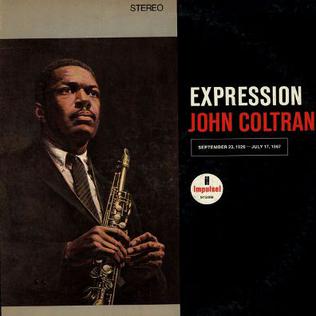
Expression is an album by jazz saxophonist John Coltrane, recorded in early 1967 and released in late September of that year, around Coltrane's birthday, and two months after his death. This was the first posthumous release of a Coltrane recording, and the last album he personally authorized.

First Meditations is an album by John Coltrane recorded on September 2, 1965 and posthumously released in 1977. It is a quartet version of a suite Coltrane would record as Meditations two months later with an expanded group. Along with Sun Ship, recorded a week earlier, First Meditations represents the final recordings of Coltrane's classic quartet featuring pianist McCoy Tyner, bassist Jimmy Garrison, and drummer Elvin Jones.
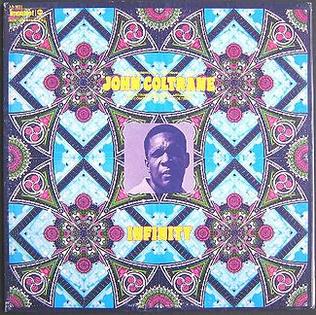
Infinity is an album credited to John Coltrane, released on Impulse! Records in 1972. It features overdubs with strings of Coltrane's pieces recorded in 1965 and 1966, at the hands of Alice Coltrane. Her controversial "re-imagining" of her husband's late works was criticised by both fans and critics, as she took his original performances and superimposed them over lush orchestral backgrounds and re-dubbed rhythm section parts, as well as recording new solos on piano, organ, harp and timpani.

Kulu Sé Mama is an album by jazz musician John Coltrane. Recorded during 1965, it was released in January 1967 as Impulse! A-9106, and was the last album released during Coltrane's lifetime.

Selflessness Featuring My Favorite Things is a posthumous album by jazz musician John Coltrane, released in 1969. The album juxtaposes two tracks recorded live at the 1963 Newport Jazz Festival with a single track ("Selflessness") recorded in a studio in Los Angeles in 1965.

Cosmic Music is a jazz album by John Coltrane and Alice Coltrane released after John Coltrane's death. John Coltrane only plays on two tracks, "Manifestation" and "Reverend King".
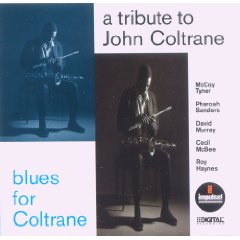
Blues for Coltrane: A Tribute to John Coltrane is a 1987 album by jazz pianist McCoy Tyner released on the Impulse! label. It features performances by Tyner, tenor saxophonists David Murray and Pharoah Sanders, bassist Cecil McBee and drummer Roy Haynes. The album received a Grammy Award for Best Jazz Instrumental Performance in 1988.

The Mastery of John Coltrane, Vol. III: Jupiter Variation is a compilation album by American saxophonist John Coltrane, which features pieces recorded in 1966 and 1967, but not released until 1978 on Impulse! Records as IA 9360. All tracks were previously unreleased, at the time of release. "Number One" may also be found on the CD reissue of Expression, while "Jupiter (Variation)" and "Leo" may be found on the reissue of Interstellar Space. "Peace on Earth", with posthumous overdubbings, can be found on Infinity. The version here is the original.
Dewey Bernard Johnson was an American free jazz trumpeter best known for his appearance on John Coltrane's historic recording Ascension.
















